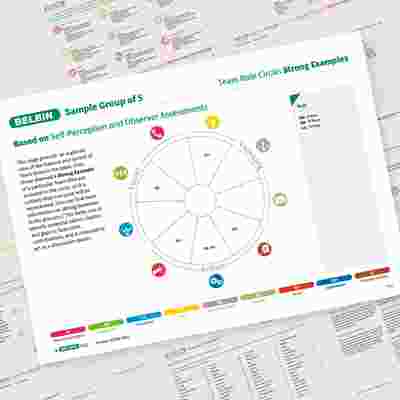Is your team set to ‘self-destruct’?
It makes your heart pound and your mouth dry. You shuffle uncomfortably from one foot to the other, trying to find a natural way to stand.
It takes courage to stand on your own, facing a group who do things differently.
We all want to belong, to be accepted – it’s a strong, primal instinct, honed for survival. And in spite of boardrooms and business suits, when we stand apart from the crowd, we take a risk.
But sometimes, in workshops and presentations, our facilitators ask people to do just that.
It’s a simple but powerful exercise. We pin the nine Team Role icons up around the room and ask people to stand beneath their top Team Role – their strongest contribution to the team.
And the picture begins to emerge.
The lone Monitor Evaluator trying to hold the reins in a team of Plants, Resource Investigators and Shapers. The only voice of caution and reason in a culture that wants action and change without careful consideration.
The sole Plant in an Implementer quagmire, trying desperately to make the case for innovation and being told that it’s ‘not how things are done round here’.

Identifying self-sabotaging coping mechanisms
When teams are under pressure, pack mentality prevails. When collective anxiety becomes intolerable, teams try to counter it with dysfunctional coping mechanisms.
This might entail making scapegoats, infighting, or ‘othering’ people, teams and departments, to put distance between the team and the threat.
These strategies might offer short-term relief, but they ultimately sabotage group dynamics and performance.
So what happens when this damaging behaviour flies under the radar? How do we identify and address self-sabotage in our teams?
N.Anand and Jean-Louis Barsoux identify a number of common unhealthy coping mechanisms which can be entrenched – and well hidden – in teams.
The scapegoat
Often, one person is labelled ‘difficult’ when what is really being expressed is discomfort.
The team is uncomfortable. Instead of trying to understand the contribution the person is trying to make, the desire is to eliminate the discomfort.
In Team Role terms, this might be someone entering an existing Team Role culture as a ‘culture add’, only to discover that their contribution is not well received.


The sole saviour
In this situation, the team might become dependent on one person to save the day. As a result, others in the team lose autonomy and fail to innovate.
The saviour in question might be a strong Shaper who is well-placed to provide direction in a crisis, but who ultimately flounders when others aren’t able to advise on strategic decisions.
Or a Completer Finisher in a culture where so much rests on getting the details right, but where no one else wants to carry the can.
This can cause a bottleneck, or even succession problems, depending upon the seniority of the person in question.
In some cases, this saviour might be cajoled into behaviours which are not natural strengths. We call this ‘Team Role sacrifice’. As a short term strategy, it can help the team to bridge a gap in required behaviours and aid team performance. In the long term, however, it is likely to result in resentment, stress and even burnout.
Fight mode
The team might become fixated on a common enemy, whether this be another team or department, head office or a competitor.
Instead of working to solve its own problems, the team places blame on this external force and expends energy fighting the wrong battles.
Flight mode
Whilst ‘fight mode’ teams are engaged in combat with a perceived enemy, teams in flight mode are avoidant – withdrawing to ward off anxiety.
Important decisions or tasks might be deferred or ignored, especially if the team is suffering from inconsistent or volatile leadership.
Addressing dysfunctional behaviour
The reasons for dysfunction may be deep-seated in team culture, but often digging deep for a short period of time doesn’t produce the sustainable change needed.
As Anand and Barsoux explain:
“Simply addressing the symptoms, through coaching, team building, experiential exercises, or training interventions, may temporarily improve attitudes and performance. But the root causes will most likely persist [...]. To truly escape problematic patterns, teams must adopt new processes and new ways of thinking and behaving – which requires more than simple interventions.”
In other words, we may be able to engage in a ‘deep-and-meaningful’ on an awayday, and this might offer temporary relief, whilst the underlying problem persists.

There is no quick fix.
These cultural problems are complex to address, and doing so is often challenging, uncomfortable work.
We need a tool that unearths real problems, but also offers practical and workable solutions.
We need a common language with which to check the team’s pulse, to identify and discuss problems arising, and to bring about sustainable behaviour change.
Stopping self-sabotage with Belbin
When dealing with complex team problems, the approach matters.
As Meredith Belbin said, “A team is not a bunch of people with job titles, but a congregation of individuals, each of whom has a role that is understood by other members.”
Psychometric tests approach team problems by focusing on the individual personalities involved.
The problem is that this is limited by each person’s self-awareness. And often the building blocks of individual personality types don’t stack up to a ‘bigger picture’ the team can recognise and work with.
The result? Oftentimes, disillusionment and inaction.

Belbin is different.
The Team Role framework was developed in response to the research question, ‘What makes teams succeed or fail?’
It is, intrinsically, a holistic, practical tool, which situates individual contributions in relation to the most tangible element of team dynamics – behaviours.
Rather than relying on the say-so of individuals and the internal workings of personality, Belbin measures behaviour. And it corroborates findings through Observer Assessments – feedback from within the team.
This builds an evidence base the team can use to uncover, diagnose and address dysfunctional dynamics.
Belbin Individual report - self vs others
Managers can see at a glance where an individual is playing out of role and ask the right questions.
- Is that contribution needed?
- Is that person the best one to make it?
- How long will they be expected to play out of role?
- How will this be acknowledged by the rest of the team?
- What strategies are in place to avoid burnout?


Belbin Team report - The Team Role Circle
When looking at the team as a whole, it is easy to see where cliques might appear. (Those with similar strengths might be most comfortable working together, but are not necessarily effective.)
A facilitator can identify a ‘lone voice’ and ask pertinent questions there too.
- Can the team recognise the value of that contribution, when they can see the results of it?
- Can the individual in question be coached to play that Team Role to best effect?
- How will they be empowered and supported by others?
As the team becomes more familiar with the Team Role language, Belbin can be used to address conflict, assign tasks and responsibilities that align with strengths, promote role flexibility and fortify support networks within the team.
A holistic approach
Addressing self-sabotage within a team requires a strategic, holistic approach which engages and empowers the team as a whole.
Through its unique inception, evidence base and unerring focus on the team, the Belbin framework is an invaluable tool for addressing and remedying dysfunctional team dynamics.
By using this methodology as a lens, teams can avoid hitting the ‘self-destruct’ button.
Rather than resorting to unhelpful coping mechanisms or allowing pack mentality to prevail, Belbin helps teams to do the important and often challenging work of recognising and addressing discomfort, celebrating cognitive diversity and unlocking the team’s full potential.
Next steps
To find out more how using the Belbin theory and reports can help your teams, please get in touch.
We'd love to hear from you and can offer a range of solutions to help you, and your teams.
Email [email protected], call +44 (0)1223 264975 or complete the form below. We look forward to hearing from you.

Webinar: Self-Sabotaging Teams
Join Jo Keeler talking about Self-Sabotaging teams, and how the language of Belbin can help.
Recorded 30th April 2024
Contact us
Please fill out the form and we'll be in touch.